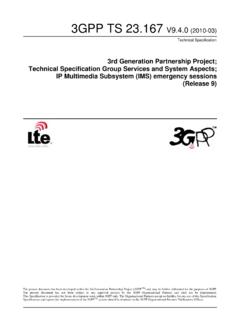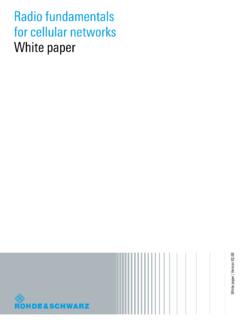Transcription of Designing High-Performance Video Systems in 7 Series …
1 Application Note: 7 Series FPGAs Designing High-Performance Video Systems in 7 Series FPGAs with the AXI Interconnect Authors: Pankaj Kumbhare and Vamsi Krishna XAPP741 ( ) April 14, 2014. Summary This application note covers the design considerations of a Video system using the performance features of the LogiCORE IP Advanced eXtensible Interface (AXI) Interconnect core. The design focuses on high system throughput using approximately 80% of DDR memory bandwidth through the AXI Interconnect core with FMAX and area optimizations in certain portions of the design. The design uses eight AXI Video direct memory access (AXI VDMA) engines to simultaneously move 16 streams (eight transmit Video streams and eight receive Video streams), each in 1920 x 1080 pixel format at 60 Hz refresh rate, and 24 data bits per pixel.
2 This design also has additional Video equivalent AXI traffic generated from four LogiCORE AXI Traffic Generator (ATG) cores configured for 1080p Video mode. The ATG core generates continuous AXI traffic based on its configuration. In this design, ATG is configured to generate AXI4 Video traffic in 1080p mode. This pushes the system throughput requirement to approximately 80% of DDR. bandwidth. Each AXI VDMA is driven from a LogiCORE IP Test Pattern Generator (AXI TPG). core. AXI VDMA is configured to operate in free running mode. Data read by each AXI VDMA. is sent to a common Video On-Screen Display (AXI OSD) core capable of multiplexing or overlaying multiple Video streams to a single output Video stream. The output of the AXI OSD.
3 Core drives the onboard high -definition media interface (HDMI technology) Video display interface through the RGB to YCrCb Color Space Converter core and LogicCORE IP Chroma Resampler core. A LogiCore Video Timing Controller (AXI VTC) generates the required timing signals. The LogiCORE AXI performance Monitor core is added to capture DDR performance metrics. DDR traffic is passed through the AXI Interconnect to move 16 Video streams over 8 VDMA. pipelines and 8 Video streams of traffic from the four ATG cores configured for 1080p Video mode. All 16 Video streams moved by the AXI VDMA blocks are buffered through a shared DDR3 SDRAM memory and are controlled by a MicroBlaze processor. The ATG cores continuously generate Video traffic to be stored in DDR memory.
4 The reference system is targeted for the Kintex -7 FPGA XC7K325 TFFG900-2 on the xilinx KC705 evaluation board, revision (See the KC705 Evaluation Board for the Kintex-7 FPGA. User Guide (UG810) [Ref 1].). Included The reference design is created and built using Vivado IP Integrator (IPI) , which is part Systems of Vivado Design Suite: system Edition. The Vivado IP integrator provides a device and platform aware, interactive environment that supports intelligent auto-connection of key IP. interfaces, one-click IP subsystem generation, real time DRCs, and interface change propagation, combined with a powerful debug capability. Creation of the reference design using the Vivado tools logic design flow is described in detail in Building Hardware, page 14.
5 The design also includes software built using the xilinx Software Development Kit (SDK). The software runs on the MicroBlaze processor subsystem and implements control, status, and monitoring functions. Complete Vivado and SDK project files are provided with this application note to allow you to examine and rebuild the design or to use it as a template for starting a new design. Copyright 2012 2014 xilinx , Inc. xilinx , the xilinx logo, Artix, ISE, Kintex, Spartan, Virtex, Vivado, Zynq, and other designated brands included herein are trademarks of xilinx in the United States and other countries. AMBA is a registered trademarks of ARM in the EU and other countries. HDMI, HDMI logo, and high -Definition Multimedia Interface are trademarks of HDMI Licensing LLC.
6 All other trademarks are the property of their respective owners. XAPP741 ( ) April 14, 2014 1. Introduction Introduction High-Performance Video Systems can be created using xilinx AXI IP. The use of AXI. Interconnect, Memory Interface Generator (MIG), and VDMA IP blocks can form the core of Video Systems capable of handling multiple Video streams and frame buffers sharing a common DDR3 SDRAM. AXI is a standardized IP interface protocol based on the Advanced Microcontroller Bus Architecture (AMBA ) specification. The AXI interfaces used in the reference design consist of AXI4, AXI4-Lite, and AXI4-Stream interfaces as described in the AMBA AXI4 specifications [Ref 2]. These interfaces provide a common IP interface protocol framework around which to build the design.
7 Together, the AXI Interconnect and AXI MIG implement a high -bandwidth, multi-ported memory controller (MPMC) for use in applications where multiple devices share a common memory controller. This is a requirement in many Video , embedded, and communications applications where data from multiple sources moves through a common memory device, typically DDR3. SDRAM. AXI VDMA implements a High-Performance , Video -optimized DMA engine with frame buffering, scatter gather, and two-dimensional (2D) DMA features. AXI VDMA transfers Video data streams to or from memory and operates under dynamic software control or static configuration modes. A clock generator and processor system reset block supplies clocks and resets throughout the system .
8 high -level control of the system is provided by an embedded MicroBlaze processor subsystem containing I/O peripherals and processor support IP. To optimize the system to balance performance and area, multiple AXI Interconnect blocks are used to implement segmented/hierarchical AXI Interconnect networks with each AXI Interconnect block individually tuned and optimized. Hardware The hardware requirements for this reference system are: Requirements xilinx KC705 evaluation board (revision ). One USB Type-A to Mini-B 5-pin cable One USB Type-A to Micro-B 5-pin cable high -quality HDMI to DVI cable (colors are not displayed properly otherwise). Display monitor supporting 1920 x 1080 pixel resolution up to 60 frames/sec (the reference design was tested using a Dell P2210T monitor).
9 The installed software tool required for building and downloading this reference system is Vivado Design Suite Reference In addition to the MicroBlaze processor, the reference design includes these cores: Design MDM. Specifics LMB block RAM. AXI_INTERCONNECT. CLOCK GENERATOR. PROC_SYS_RESET. AXI_UARTLITE. AXI IIC. AXI_INTC. MIG. AXI_BRAM. AXI_VTC. AXI_TPG. XAPP741 ( ) April 14, 2014 2. Reference Design Specifics AXI_VDMA. AXI_PERFORMANCE_MONITOR. AXI_OSD. AXI4-Stream to Video Out RGB2 YCrCB Converter Chroma Resampler AXI Traffic Generator HDMI_OUT IP. Figure 1 and Table 1 show a block diagram and address map of the system , respectively. X-Ref Target - Figure 1. D DD d' d' . DD . y/ DD .. y/ W s D s D s D s D Z' . D/' . D.
10 Z Z . ^ .. s . K^ .. dW' dW' dW' dW' s . y/ , D/ K . h Zd / . y/ . D D sd . / y/ // .. y/ > s y . Figure 1: Reference system Block Diagram Table 1: Reference system Address Map Peripheral Instance Base Address high Address AXI interrupt controller axi_intc_1 0x41200000 0x4120 FFFF. LMB block RAM controller microblaze_0_local_memory/. 0x00000000 0x0001 FFFF. dlmb_bram_if_cntlr LMB block RAM controller microblaze_0_local_memory/i 0x00000000 0x0001 FFFF. ilmb_bram_if_cntlr MDM mdm_1 0x41400000 0x4140 FFFF. XAPP741 ( ) April 14, 2014 3. Hardware system Specifics Table 1: Reference system Address Map (Cont'd). Peripheral Instance Base Address high Address AXI UartLite axi_uartlite_1 0x40600000 0x4060 FFFF. MIG mig_1 0x80000000 0xBFFFFFFF.














